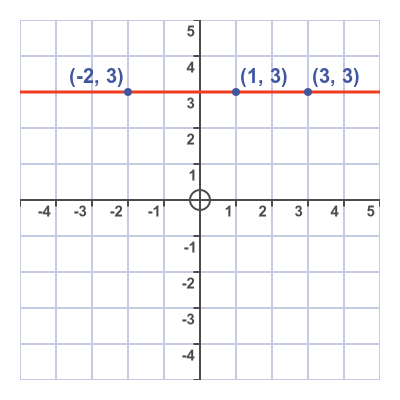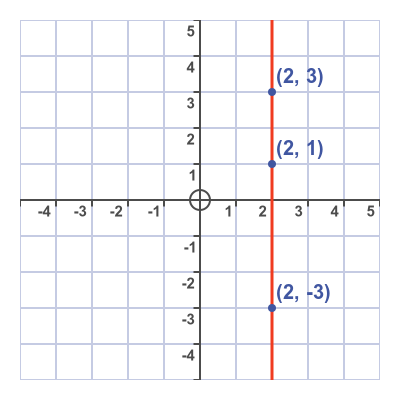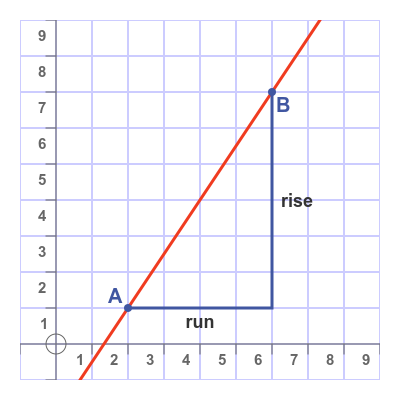Gradient of a line
Categories: gcse graphs
Level:

The gradient measures the slope of a line.
Finding the gradient
To find the gradient of a line, we need to know two points on the line. We can then work out the gradient from the formula:
$$ gradient = \frac{change\ in\ y}{change\ in\ x} $$
We will find the gradient of this line:

We have marked two points on the line:
- A (2, 2)
- B (5, 8)
It is important to use accurate points, otherwise, the gradient will not be accurate. We have chosen two points where the line passes through the grid of the graph paper, so the coordinates are exact whole numbers.
We find the change in x by subtracting the x-coordinate of A (which is 2) from the x-coordinate of B (which is 5):
$$ {change\ in\ x} = 5 - 2 = 3 $$
We find the change in y by subtracting the y-coordinate of A (which is 2) from the y-coordinate of B (which is 8):
$$ {change\ in\ y} = 8 - 2 = 6 $$
So we can calculate the gradient using the formula:
$$ gradient = \frac{change\ in\ y}{change\ in\ x} = \frac{6}{3} = 2 $$
The gradient is positive, which means that the line goes uphill.
Negative gradients
This line goes downhill, so we would expect it to have a negative gradient:

Here are two points on the line:
- A (2, 6)
- B (6, 3)
Again we find the change in x by subtracting the x-coordinate of A (which is 2) from the x-coordinate of B (which is 6):
$$ {change\ in\ x} = 6 - 2 = 4 $$
And we find the change in y by subtracting the y-coordinate of A (which is 6) from the y-coordinate of B (which is 3):
$$ {change\ in\ y} = 3 - 6 = -3 $$
We must subtract A from B. Don't make the mistake of always subtracting the smallest from the largest! These values give a gradient of:
$$ gradient = \frac{change\ in\ y}{change\ in\ x} = \frac{-3}{4} = -0.75 $$
This time the gradient is negative, which means that the line goes downhill.
Check that the sign is correct
If you always subtract A from B for both x and y, you should always find that the value is positive for uphill curves, and negative for downhill curves.
But it is always worth checking. For example, if you calculate a positive gradient when the curve has a downhill slope, then you have made a mistake. Check that you have done the subtractions the right way round.
What does the gradient measure?
The gradient tells us how much y changes if we change x by one.
Special cases
We previously looked at horizontal and vertical lines. What gradients do those lines have?
Here is a horizontal line:

If we apply the formula to two of the points, (1, 3) and (3, 3), the result is:
$$ gradient = \frac{change\ in\ y}{change\ in\ x} = \frac{3-3}{3-1} = 0 $$
The gradient is zero. The line is neither uphill nor downhill, and zero is neither positive nor negative.
Here is a vertical line:

If we apply the formula to two of the points, (2, 1) and (2, 3), the result is:
$$ gradient = \frac{change\ in\ y}{change\ in\ x} = \frac{3-1}{2-2} = \frac{2}{0} $$
We can't divide 2 by 0, so the gradient of a vertical line is undefined.
Run and rise
The change in x is sometimes called the run, and the change in y is sometimes called the rise:

These are just different names for the change in x and y. The gradient is then given by:
$$ gradient = \frac{rise}{run} $$
For negative gradients, the change in y is usually called the fall.
Related articles
Join the GraphicMaths Newsletter
Sign up using this form to receive an email when new content is added to the graphpicmaths or pythoninformer websites:

Popular tags
adder adjacency matrix alu and gate angle answers area argand diagram binary maths cardioid cartesian equation chain rule chord circle cofactor combinations complex modulus complex numbers complex polygon complex power complex root cosh cosine cosine rule countable cpu cube decagon demorgans law derivative determinant diagonal directrix dodecagon e eigenvalue eigenvector ellipse equilateral triangle erf function euclid euler eulers formula eulers identity exercises exponent exponential exterior angle first principles flip-flop focus gabriels horn galileo gamma function gaussian distribution gradient graph hendecagon heptagon heron hexagon hilbert horizontal hyperbola hyperbolic function hyperbolic functions infinity integration integration by parts integration by substitution interior angle inverse function inverse hyperbolic function inverse matrix irrational irrational number irregular polygon isomorphic graph isosceles trapezium isosceles triangle kite koch curve l system lhopitals rule limit line integral locus logarithm maclaurin series major axis matrix matrix algebra mean minor axis n choose r nand gate net newton raphson method nonagon nor gate normal normal distribution not gate octagon or gate parabola parallelogram parametric equation pentagon perimeter permutation matrix permutations pi pi function polar coordinates polynomial power probability probability distribution product rule proof pythagoras proof quadrilateral questions quotient rule radians radius rectangle regular polygon rhombus root sech segment set set-reset flip-flop simpsons rule sine sine rule sinh slope sloping lines solving equations solving triangles square square root squeeze theorem standard curves standard deviation star polygon statistics straight line graphs surface of revolution symmetry tangent tanh transformation transformations translation trapezium triangle turtle graphics uncountable variance vertical volume volume of revolution xnor gate xor gate
